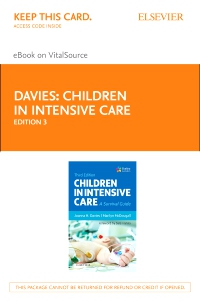
Children in Intensive Care Elsevier eBook on VitalSource (Retail Access Card), 3rd Edition
Elsevier eBook on VitalSource - Access Card

-
- Information presented in quick reference format, with accompanying reference tables, to facilitate on-the-spot usage
- Advanced Life Support Group algorithms provide safe and easy-to-follow protocols to the management of emergency situations
- Contains input from a broad range of paediatric specialists – intensivists, anaesthetists, haematologists, oncologists, air ambulance physicians and retrieval nurses, pharmacists, specialist dieticians, and respiratory physiotherapists – to ensure full coverage and accuracy of information
- Contains helpful ‘Quick Guide’ and ‘Warning’ boxes to provide key information at a glance, while helpful mnemonics assist with learning
- Contains chapters on normal child development, safe-guarding children and young people, and patient transport
- Perfect for use on the wards, theatres, high-dependency units and intensive care units as well as during retrieval and A&E
- Ideal for newcomers and experienced staff alike, whether they be junior doctors or nursing staff
-
- Additional authorship brings the expertise of Marilyn McDougall, a Senior Paediatric Intensive Care Consultant
- Contains brand new chapters - oncology emergencies and pain & sedation - as well as the latest information on topics including sepsis and the collapsed neonate, and care of children after spinal surgery
- Comprehensively expanded cardiac chapter presents new surgical approaches as well as practical tips on pacing, care of chest drains and basic echocardiograph terminology
- Drug chapter now includes reversal agents, new drug profiles and an updated compatibilities chart
- Expanded artwork program explains clinical concepts and practical procedures
-
1 All about resuscitation
Cardiopulmonary assessment, The initial approach to basic life support and life support algorithms, Early treatment of ventricular tachycardia, Intraosseous access, Use of the defibrillator, Shock, Useful mnemonics, Newborn resuscitation, Management of a blocked tracheostomy, Needle thoracocentesis, Management of anaphylaxis
2 Airway and breathing: Including common respiratory problems and blood gas interpretation
Upper respiratory tract, Lower respiratory tract, Pneumonia, Paediatric acute respiratory distress, Acid–base balance and interpretation of blood gases, Systematic review of chest X-ray, Means and methods of oxygen delivery, Intubation, Ventilation and definition of terms, Indications for assisted ventilation, Modes of ventilation, High-frequency ventilation, Capnography, Use of inhaled nitric oxide
3 Cardiac care
The normal heart, The normal electrocardiogram (ECG), Cardiac output, Invasive intravascular pressure monitoring, Top tips for post-operative cardiac management, Important post-operative problems, Removal of a left atrial line, Classification of congenital heart disease, Blocked BT shunt, Arrhythmias, ECMO
4 The kidneys and renal replacement
Key concepts, New biomarker, Acute kidney injury, Peritoneal dialysis (PD), Continuous veno-venous haemofiltration, Continuous veno-venous haemodiafiltration (CVVHD), Haemodialysis, Fluids for CVVH/CVVHD, Anticoagulation, Plasma exchange, Renal disease, Hypertensive crisis
5 Liver function and failure
The jaundiced baby, Biliary atresia, Acute liver failure, Portal hypertension, Sengstaken tube, Liver transplant Hepatorenal syndrome (HRS), Hepatopulmonary syndrome
6 Neurology – Assessment and management
Guidelines for neurological assessment, The cranial nerves, Identification and management of raised intracranial pressure, Intracranial Pressure monitoring, Common diagnostic tests, Diabetes insipidus, Seizures, Dystonia, Demyelinating conditions, Acute disseminated encephalitis (ADEM), Transverse myelitis, Myasthenia gravis, Meningitis, Posterior reversible, leukoencephalopathy syndrome (PRES)
7 Oncology emergency
Caring for an oncology patient in PICU – general principles, Central venous access, Chemotherapy – common side effects, Oncology emergencies, Oncology terminology, Specialist oncology drugs, Care of PICC line, Accessing a Port-A-Cath
8 Fluids and nutrition
Guidelines, Enteral feeding, Types of feeding and products available, Special diets for special kids, Total parenteral nutrition, Insensible loss, Burns
9 Blood and electrolytes: normal values, special tests and transfusion
Normal values: full blood count, Transfusion components, Major haemorrhage, Transfusion Compatibility, RhD Antigens, Special requirements – Irradiated, CMV or Hepatitis, E-negative irradiated blood products
10 Drugs – inotropes, vasodilators, sedatives, analgesics and muscle relaxants
Resuscitation drugs, Drugs for intubation, Quick reference guide for calculating infusions, Inotropic and chronotropic drugs, Drugs commonly used intravenous infusions, Therapeutic drug monitoring
11 Pain and sedation
Assessing pain and sedation, Treating children in pain, Red flags, Pain summary
12 Handy hints for various conditions
Sepsis, Necrotising fasciitis, Neonatal collapse, Sickle cell crisis, Diabetic ketoacidosis (DKA), Syndrome of inappropriate antidiuretic hormone secretion, Burns, Care of child post scoliosis surgery
13 Transport of critically ill infants and children – intra and inter-hospital transport
Transport team composition, Time critical transfer – Neurosurgical emergency and acute abdomen, Awaiting the paediatric critical care transport team – What can you do to help? Arrival of the paediatric critical care transport team, Before transfer, In transit, Looking after yourself, ABCDE Transfer guidance
14 Safeguarding children and young people
Safeguarding children policies and training, Types of child abuse, Looked after children (LAC), Female genital mutilation, Human trafficking, Conclusion
15 Death of a child
Expected death in PICU, Palliative care, The nurse’s role, The doctor’s role, Organ donation, Brain stem death diagnosis, Investigations that may be required prior to organ donation, Clinical management guidelines of the organ donor, Religion
16 Child development
Normal child development, Children’s developmental concepts of pain
17 Quick reference to syndromes
Abbreviations